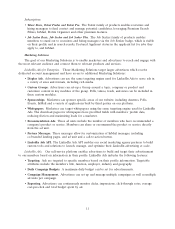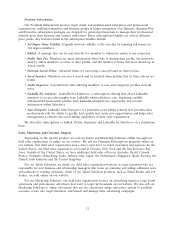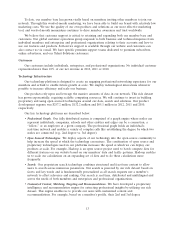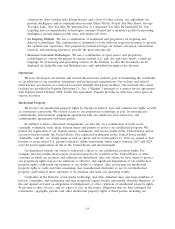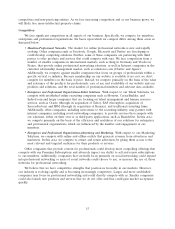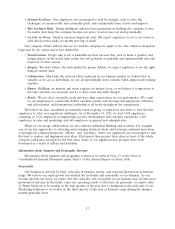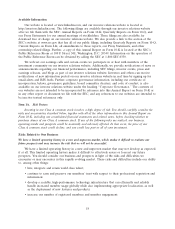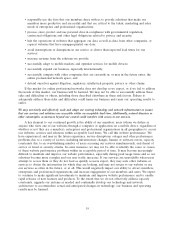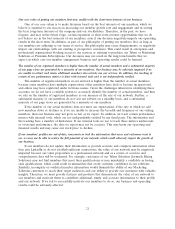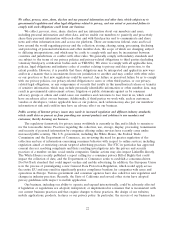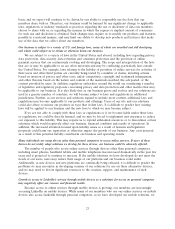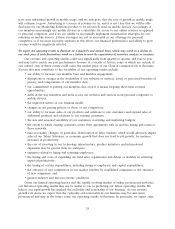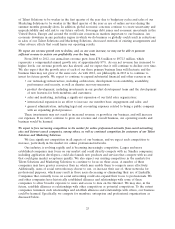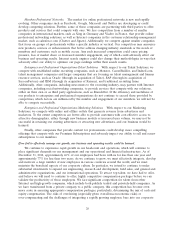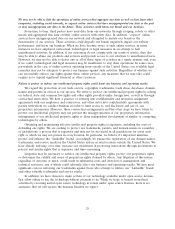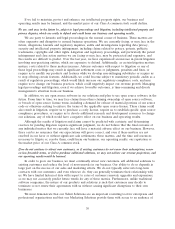LinkedIn 2012 Annual Report Download - page 23
Download and view the complete annual report
Please find page 23 of the 2012 LinkedIn annual report below. You can navigate through the pages in the report by either clicking on the pages listed below, or by using the keyword search tool below to find specific information within the annual report.Our core value of putting our members first may conflict with the short-term interests of our business.
One of our core values is to make decisions based on the best interests of our members, which we
believe is essential to our success in increasing our member growth rate and engagement and in serving
the best, long-term interests of the company and our stockholders. Therefore, in the past, we have
forgone, and may in the future forgo, certain expansion or short-term revenue opportunities that we do
not believe are in the best interests of our members, even if our decision negatively impacts our operating
results in the short term. In addition, as part of our philosophy of putting our members first, as long as
our members are adhering to our terms of service, this philosophy may cause disagreements, or negatively
impact our relationships, with our existing or prospective customers. This could result in enterprises and
professional organizations blocking access to our services or refusing to purchase our Talent or Marketing
Solutions or Premium Subscriptions. Our decisions may not result in the long-term benefits that we
expect, in which case our member engagement, business and operating results could be harmed.
The number of our registered members is higher than the number of actual members and a substantial majority
of our page views are generated by a minority of our members. Our business may be adversely impacted if we
are unable to attract and retain additional members who actively use our services. In addition, the tracking of
certain of our performance metrics is done with internal tools and is not independently verified.
The number of registered members in our network is higher than the number of actual members
because some members have multiple registrations, other members have died or become incapacitated,
and others may have registered under fictitious names. Given the challenges inherent in identifying these
accounts, we do not have a reliable system to accurately identify the number of actual members, and thus
we rely on the number of registered members as our measure of the size of our network. Further, a
substantial majority of our members do not visit our website on a monthly basis, and a substantial
majority of our page views are generated by a minority of our members.
If the number of our actual members does not meet our expectations, if the rate at which we add
new members slows or declines or if we are unable to increase the breadth and frequency of our visiting
members, then our business may not grow as fast as we expect. In addition, we track certain performance
metrics with internal tools, which are not independently verified by any third party. The information and
the tracking have a number of limitations. If our internal tools we use to track these metrics undercount
or overcount performance, the data we report may not be accurate. This may harm our operating and
financial results and may cause our stock price to decline.
If our members’ profiles are out-of-date, inaccurate or lack the information that users and customers want to
see, we may not be able to realize the full potential of our network, which could adversely impact the growth of
our business.
If our members do not update their information or provide accurate and complete information when
they join LinkedIn or do not establish sufficient connections, the value of our network may be negatively
impacted because our value proposition as a professional network and as a source of accurate and
comprehensive data will be weakened. For example, customers of our Talent Solutions (formerly Hiring
Solutions) may not find members that meet their qualifications or may misidentify a candidate as having
such qualifications, which could result in mismatches that erode customer confidence in our solutions.
Similarly, incomplete or outdated member information would diminish the ability of our Marketing
Solutions customers to reach their target audiences and our ability to provide our customers with valuable
insights. Therefore, we must provide features and products that demonstrate the value of our network to
our members and motivate them to contribute additional, timely and accurate information to their profile
and our network. If we fail to successfully motivate our members to do so, our business and operating
results could be adversely affected.
21


